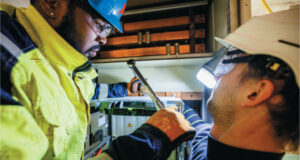
Tor Idhammar is president, IDCON, Inc. You can reach him at [email protected]
I would like to extend a large thank you to Larry for the kind words and to the whole TAPPI team for enhancing reliability & maintenance content for TAPPI members. IDCON is looking forward to helping the partnership grow and succeed. For you who don’t know IDCON, here is a very short introduction:
IDCON is a reliability and maintenance management consulting firm focused on helping mills and corporations establish improved equipment reliability. We work hands-on with mill people from corporate managers to craftspeople. One week, we’ll work with a corporate team to establish best practices on reliability; the next we’ll work with a planner to plan, or a craftsperson to do equipment inspection. We are a family-owned company established by Christer Idhammar (my father) in 1972. Many of you know Christer through his many articles, conferences, and mill visits. He is still active in the firm, but I have been leading the company since 2009.
To kick of the leadership series, I would like to touch on the partnership between operations and maintenance in our mills. I think the partnership is crucial to achieve reliable production.
In my experience, it is common to find the relationship to be adversarial, instead of a close partnership. Operations often see themselves as a “customer” of maintenance, and maintenance therefore becomes a service provider. This relationship is not always established in the organizational structure—yet it is embedded in the culture. In a customer/service provider relationship, it would be obvious that operations would be responsible for the cost. However, it is common to see maintenance responsible for the cost even though operations is the “client” asking for service. A non-paying client can create tension and animosity between the departments and build walls rather than create a partnership.
A customer/service provider relationship also fosters emotionally-based priorities for maintenance work. When a customer wants something, the service supplier typically says “yes, sir.” Work orders are therefore not always critically evaluated as to what is the most important work to execute for the mill as a whole. Operations tends to focus on short-term production goals while maintenance looks at the long-term equipment reliability for electrical, instrumentation, and mechanical equipment.

World-class performance can only be achieved in a reliability partnership work system. This graphic shows the engineering, maintenance, and operations partnership, with key responsibilities for reliability.
While operations are experts in the manufacturing process, it is unusual to see an operations manager with extensive operations AND maintenance skills. A customer/service provider relationship will therefore create unreliable equipment since the “customer” doesn’t know what the equipment truly needs. It is not uncommon to see lubricators being pulled off to do scaffolding work for a shutdown (now we are missing lube points), or for planners to substitute as supervisors (now we have no planning for the area.)
So, how can a mill start improving the relationships between operations and maintenance?
First, I think it is important to understand each other’s role and expertise. Operations staffers are the experts in the process and should be responsible for process reliability. Maintenance staffers are experts in equipment and should be responsible for equipment reliability. We haven’t touched on engineering in this article yet, but engineers are experts in design and project management and should be responsible for design reliability. There is a lot of overlap and interaction between the departments, but each department’s key responsibility must be defined.
Second, the mill and corporation need to agree on joint goals. Most paper companies would agree that the goal is to improve reliability (measured by OEE) and reduce total cost/ton. The common tug-of-war is the time frame for the goals. Production often tries to improve shift and daily production numbers, while maintenance often focuses on long-term equipment reliability, but can sometimes be slow to reduce the total backlog of work in the mill.
If the partnership were to be put into practice, the long-term thinking could, for example, mean that:
- Operations would allow maintenance the time to align a pump to 2/1000 of an inch instead of starting up the paper machine early during a shutdown.
- We would prioritize work according to established criteria and remove unnecessary work orders from the backlog.
- We would train our people in trade skills and maintenance management work processes. Operators would be trained in the operation of equipment from a reliability perspective.
- We would not defer repairs more than absolutely necessary.
- Operations and maintenance would have a weekly priority meeting to jointly prioritize work orders.
- Operations and maintenance would solve problems jointly using a root cause process.
Summary
As a starting point for improving reliability and build a partnership between your departments, I suggest the following:
- Define and communicate the partnership relationship between departments.
- Clarify the “product” of maintenance. It is reliability, not “wrench time.”
- Define roles for each department.
- Set long-term joint goals and act according to the goals.
- Reward departments according to the long-term goals.
 Paper 360
Paper 360
